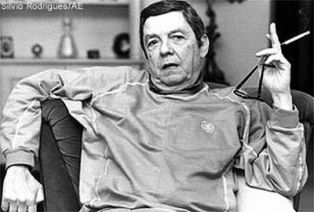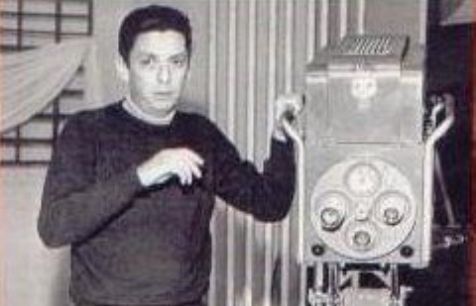Ellis Pérez
Ellis Pérez, quien recientemente cumplió cincuenta años de dedicación al trabajo en los medios de comunicación, carrera que según afirma no ha sido tarea fácil, pero sí de muchos logros.
Se inicia en el área en 1953, en la emisora HIZ, con la transmisión en inglés del Hit Parade, una selección de las canciones más populares de la semana en Estados Unidos, marcando así, el comienzo de la revolución de la música juvenil de la época en el país.
“Yo hice carrera sin condiciones básicas, pero aprendí a hacer mi trabajo, porque para ese tiempo HIZ era un nido de los mejores exponentes de la locución dominicana”.
Expresa que no fue algo buscado, porque lo menos que había pensado en su vida era ser locutor y llegar a ser un hombre de los medios de comunicación.
En el 1964 se instala en la Radio Universal con la transmisión de American Music, una programación que incluía los discos más actualizados de la música norteamericana de entonces.
Explica que su experiencia ha sido muy gratificante, una universidad continua, porque para estar en los medios, si se va a realizar un trabajo de manera efectiva uno tiene que educarse adecuadamente y mantener ese proceso de educación continua para de esa manera, enriquecer el intelecto y la condición de comunicador.
“Doy gracias a Dios por enriquecerme en el área y por ser un comunicador. He tenido la oportunidad de ligar las profesiones de comunicador y turismo, y la oportunidad de darme a la gente y enriquecerme culturalmente, cuya riqueza no tiene precio”.
Aclara que para alcanzar el éxito en cualquier actividad por simple que sea, no debe faltar el sentido de dedicación a lo que se hace, el sentido de compromiso y de identificación fácil.
Expresa que en el área de la comunicación hay que cuidar la dicción, redacción, apariencia y forma en que se dirige al público, pero si las cosas se hacen con sentido de seriedad, compromiso y dedicación, el final de la tarea será positivo.
Recomienda a los futuros profesionales de la comunicación a prepararse y sacrificarse en ciertas ocasiones para lograr el éxito, porque la vida está llena de triunfos.
“He trabajado en mis propios proyectos desde el año 1959, cuando me marché de turismo y regresé en 1963, para entonces instalar a Radio Universal. Me he sentido muy independiente y soy independiente. Generalmente me he involucrado en más de 2, 3 ó 4 diferentes pequeñas cosas para mantener esa condición de independencia.
Fue director de comunicaciones del Aeropuertos Dominicanos (AERODOM); asesor turístico del Poder Ejecutivo; asesor turístico del Senado de la República; asesor del Proyecto Turístico Playa Macao, dentro del área del sector privado y miembro del Consejo de Directores del Proyecto Cap Cana.
Gusta de la lectura de Mario Vargas Llosa y Gabriel García Márquez, por ser los relatores de esta época en Latinoamérica. De Vargas Llosa me atrae su interés por la sociedad y su mantenimiento sobre el tapete a través de sus trabajos periodísticos. Es un analista agudo muy racional e inteligente.
Sin embargo, siendo muy joven leyó Los factores del triunfo, cuyo contenido es de realización personal; de la autoría de Waldo Swingle, del cual tuvo un impacto extraordinario.
Ese libro me ayudó a forjarme y formarme en algunos de mis criterios de vida, que luego habrían de moldear mi estilo y es por eso que esa obra nunca la olvido. En su libro, Swingle, planteaba todas esas pequeñas y simples cosas de que nada viene fácil, que todo requiere dedicación, trabajo, persistencia y esfuerzo.
Para Pérez, el gran artista de esta época en República Dominicana lo es Juan Luis Guerra, por poseer los elementos y condiciones en formación y sentimiento. Juan Luis es un artista extraordinario y un orgullo de nosotros los dominicanos en diferentes aspectos.
Señala que Charitín Goico también debe ser orgullo de los dominicanos, porque ha tenido una carrera extraordinaria, así como Rhina Ramírez. Además, admira la durabilidad de Niní Cáffaro. Fui miembro del jurado del Primer Festival de la Canción Dominicana, donde Niní Cáffaro participó y se eligió la canción Por amor.
Don Ellis Pérez dedica su tiempo libre a escuchar música de Rafael Solano. No lo digo por la amistad que nos une, sino por su real condición de gran músico y el sentido musical que ha tenido toda su vida.
Ellis, como se le conoce artísticamente, es una persona que no guarda reconocimientos. Si no puede dar una impresión en los primeros minutos de una interacción, entonces considera no haber realizado su trabajo. Actualmente es el director Dirección General de Cine República Dominicana.
























